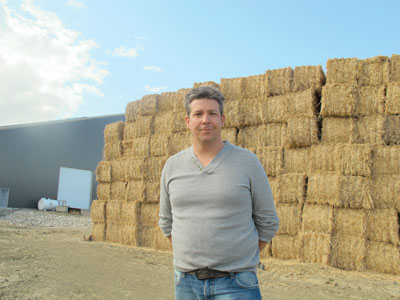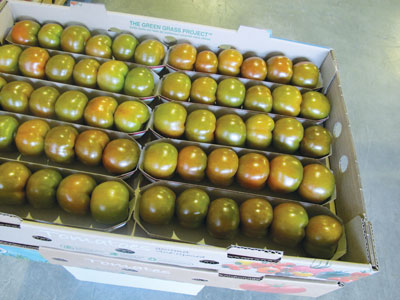
Miscanthus is proving to be an especially versatile crop, with a number of applications for the greenhouse sector.
Miscanthus is proving to be an especially versatile crop, with a number of applications for the greenhouse sector.
 |
|
| Dean Tiessen, of New Energy Farms, says miscanthus has a variety of applications. Advertisement
|
Easily incorporated into potting soil mixes, utilized in bio-packaging for the delivery and display of vegetables and used in hydroponic growing media, it is also a highly touted energy crop.
For livestock producers, miscanthus provides excellent bedding material, being 30 per cent more absorbent than premium sawdust and offering better odour control and more evaporation.
For manufacturers, it can be used in new fibre production for a range of products.
In short, it’s the “Swiss Army knife” of plants.
New Energy Farms (NEF) of Leamington, Ontario, is leading the development of dedicated biomass feedstocks for these products.
Company president Dean Tiessen has been front and centre in the commercialization of miscanthus over the past few years.
He and his family were first drawn to it for its energy crop potential in 2007. The previous year, Pyramid Farms, which Dean co-owns with his brother Jason, converted from burning fossil fuels to biomass.
The brothers soon began researching their options, concerned traditional biomass sources might rise in price if increased demand caused shortages.
“That’s what prompted us to look at developing long-term feedstock supplies,” Tiessen explains. “That’s what led us to consider growing our own fuel.”
Depending on fuel and electricity costs, energy can represent 30 to 40 per cent of most greenhouse budgets.
NEF has been growing miscanthus for the past four years without any crop inputs. The yields are currently 9.5 to 10.5 tons of dry matter per acre. That would represent close to 200 gigajoules of energy per acre.
The company is studying whether applying inputs would increase yields.
“We now have a good idea of what varieties work the best,” says Tiessen. “We’ve gone through some significant learning curves.”
The company’s miscanthus varieties are sterile (and therefore non-invasive), and have to be vegetatively propagated.
NEF is working with companies around the world. It’s even in the business of developing planting, harvesting and storage systems for energy crops.
Natural gas prices are currently quite low, meaning there’s no pressure for area growers to move to alternative fuels. But natural gas prices won’t remain low forever. “We’re not giving up hope of one day supplying biomass to other growers in the area,” says Tiessen.
In the meantime, NEF is developing supplies and contracts for higher value products – such as biocomposites, auto parts and animal bedding – by taking out the premium fibres and leaving the remainder as a fuel supplement for the family’s biomass boilers (which primarily burn wood waste material).
NORTH AMERICA’S FIRST BIOPROCESSING FACILITY
■ New Energy Farms constructed the first energy crop bioprocessing facility in North America last fall. The 30,000-square-foot facility will process locally grown energy crop biomass and convert it into a range of high quality, low carbon bioproducts.
 |
|
| Pyramid Farms has been a niche market leader for many years.
|
(The building, it should be noted, also generates 265 kilowatts of solar electricity from roof panels.)
The facility uses patented technology to fractionate the biomass from locally grown miscanthus.
The production of such feedstocks can be carried out on lower quality or surplus land and therefore won’t have an impact on food production.
GREAT POTENTIAL SEEN FOR ENERGY CROPS
■ European Union and U.S. studies have said that over 30 million hectares of land is available for production of energy crops without impacting food production.
That’s not to say miscanthus can’t already compete as a fuel. In regions lacking natural gas infrastructure, “it is golden.” Propane and oil haven’t dropped in price as steeply as natural gas.
“Our goal when we started out with this was to reduce our fuel costs,” says Tiessen.
And they’re doing just that. If they extract 40 per cent of the bale for other value-added uses and cover their costs, “anything left over is a reduced cost if used as fuel.”
NEF is currently growing about 800 acres of miscanthus, the largest single planting in North America, with new acreage added each year.
LARGEST MISCANTHUS GERMPLASM COLLECTION IN THE WORLD
■ The company also has the largest germplasm collection in the world, with significant breeding work done in Leamington.
What’s more, the company is working with a U.K. company – Muddy Boots Software – to develop software to enable farmers and landowners to produce and trade sustainable feedstocks.
NEF has other offices in the U.K. and Georgia. It is working on projects in the Ukraine, Bulgaria, Poland and the Netherlands, primarily to produce fuel for combined heat and power projects. There are other projects in England, Ireland and Wales.
In the U.S., New Energy Farms is working with various groups that have convergent technologies for second generation biofuels (meaning the conversion of cellulose fuel) replacing corn as a feedstock.
“This is becoming one of our main focuses,” says Tiessen. “As well there are many areas in North America that do not have natural gas infrastructure so feedstocks like miscanthus can be a full fuel replacement for heat and power.”
The key to a successful biomass fuel is having a strong, local market. “You can’t ship biomass long distances, it’s not economical.”
Miscanthus is a biomass winner. “In chip format, it’s very dry and light. It burns clean and hot. The ash is much lower than the waste wood we’re burning. There is little to no ash with miscanthus.”
U.S. COMMITTED TO BIOFUEL DEVELOPMENT
■ The U.S. has a goal of replacing 30 per cent of petroleum consumption with biofuels by 2030.
A miscanthus crop can be productive for a quarter-century or so. It can grow four metres in a single season.
“We’ve put a lot of effort into this opportunity,” says Tiessen. “It’s led to an enormous number of opportunities. The whole process is quite exciting.”
• www.newenergyfarms.com
Print this page